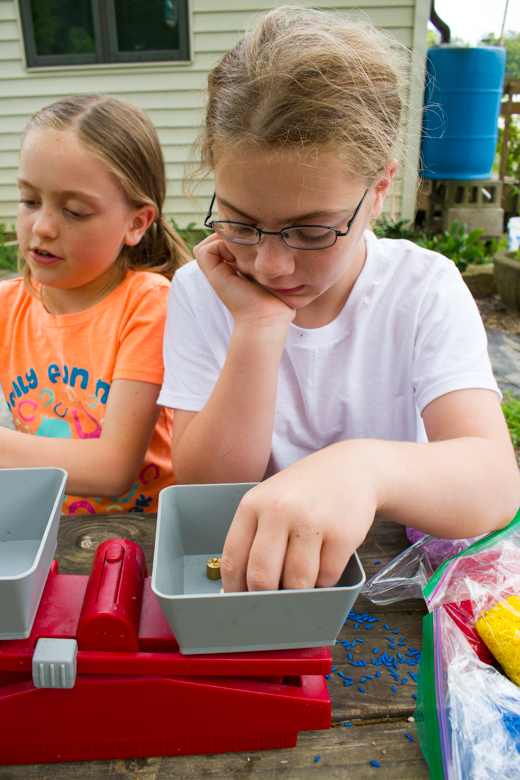There are many good teachers who still rely on hands-on methods, of course, but, nevertheless, I've been spending a LOT more time on math research in the past couple of years, sussing out my own hands-on methods to present these skills to the kids in ways that actually make sense to them.
For instance, I had to do a ton of research when the older kid began a recent unit on the metric system, specifically metric conversions. In her Math Mammoth curriculum, multiplying and dividing by powers of ten and multiplying and dividing by decimals and metric conversions are all tied up together, and she's been struggling to comprehend the basic concept uniting them all (struggling so much that I suspect that this isn't an age-appropriate concept for her to be expected to master, but that's a different issue to discuss with you on a different day, perhaps).
Powers of ten, especially, can be hard to make hands-on, because, of course, things get big (and small) FAST. I mean, have you seen the "Powers of Ten" documentary? If you haven't, stop and watch it right now. It's required viewing for all of humanity:
Metric conversions, however, do allow for a bit of modeling of powers of ten and multiplication and division by them, how much so depending on your equipment. When the older kid modeled liter conversions, for example, she could manipulate and visualize measurements from 1 milliliter to 1 liter. For the gram conversions in this activity, the children could manipulate and visualize measurements from 1 gram to 1 kilogram.
Prior to the activity, I made the older kid a chart that was simply a row of the metric conversion chart (kilogram, hectogram, decagram, gram, decigram, centigram, milligram) copied out seven times, with space to write the conversions above each row. I set out our balance scale
Although the kids worked together on this project, the younger kid hasn't yet really studied metric conversions, so she helped with weighing the rice, then she poured each measurement into its Ziplock bag and labeled it while the older kid calculated its conversions on her chart.
To begin, I challenged the kids to accurately measure out 1 gram of rice. This required a lot of cooperating/bickering. Of COURSE.
Once both children were in some semblance of agreement, or rather after they'd grown weary of one kid insisting the rice was too heavy and picking out individual grains while the other kid insisted that her sister was incorrect and the rice was too light and putting back individual grains as they were removed, etc., the younger kid poured the gram of rice into a clear plastic baggie and labeled it "1 gram" while the older kid wrote a "1" over the gram entry on the top row of her conversion chart, and then calculated the conversions of 1 gram up to 1 kilogram and down to 1 milligram.
To also model this with Base Ten blocks, first ask the child to imagine that 1 unit represents 1 gram. Lay out the ten bar, the hundred flat, and the thousand cube with the decagram, hectogram, and kilogram, respectively, then tell the child, "If one unit represents one gram, then this ten bar represents one decagram, or ten units. What is the decimal that represents one unit in this ten bar? That is the decimal that represents one gram in the decagram."
Continue up through kilogram.
To convert down to milligrams, lay the Base Ten blocks out so that the thousand cube represents one gram, the hundred flat represents one decigram, the ten bar represents one centigram, and the unit represents one milliliter. Ask your kid the same types of questions, this time asking them to imagine that the thousand cube now represents one whole gram.
You can use this modeling system for the entire metric conversion chart; every time there's a "1", whether that's 1 decagram or 1 decigram, you can model that as both one unit, using the unit cube, or one whole, using the thousand cube.
Measuring out a decagram of rice is also pretty straightforward with our set of weights, but measuring out 1 hectogram required the children to add gram weights to reach 100--
--and when it was time to measure out 1 kilogram, they were stumped. "We don't have a 1 kilogram weight or anything that adds up to make 1 kilogram!" the older kid noted.
"Hmmm, how could you solve that problem," I asked?
No clue.
"I see that you have 1 gram of rice, 1 decagram of rice, and 1 hectogram of rice. Could any of that help?"
A-ha! The children decided that if they measured out 1 hectogram of rice ten times, they would have 1 kilogram.
YAY for metric conversions!!!
Unlike the liter conversions, which got poured over the older kid's head in the end, these gram conversions get to stay with us as permanent metric models:
And now I need to make a new batch of dyed dry rice, because kilograms are BIG!!!
Anybody got any other good metric conversion activities for me? I need ones that are not so much lessons, but that we can incorporate into our lives, the same way that the big kid is now responsible for calculating all restaurant tips, on account of $32.68 x .2 is multiplication with decimals!
P.S. Want to follow along with my craft projects, books I'm reading, dog-walking mishaps, encounters with Chainsaw Helicopters, and other various adventures on the daily? Find me on my Craft Knife Facebook page!




No comments:
Post a Comment